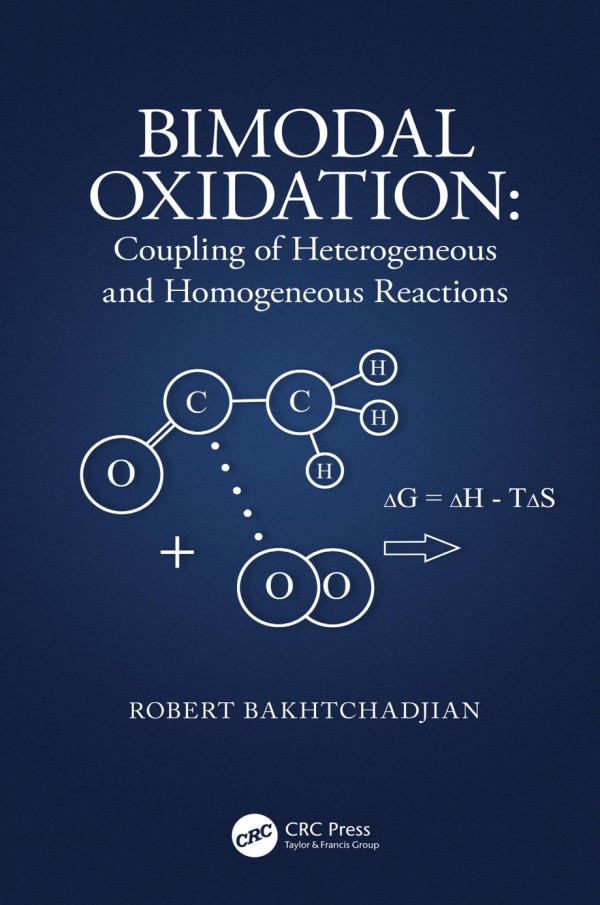

Most ebook files are in PDF format, so you can easily read them using various software such as Foxit Reader or directly on the Google Chrome browser.
Some ebook files are released by publishers in other formats such as .awz, .mobi, .epub, .fb2, etc. You may need to install specific software to read these formats on mobile/PC, such as Calibre.
Please read the tutorial at this link. https://ebooknice.com/page/post?id=faq
We offer FREE conversion to the popular formats you request; however, this may take some time. Therefore, right after payment, please email us, and we will try to provide the service as quickly as possible.
For some exceptional file formats or broken links (if any), please refrain from opening any disputes. Instead, email us first, and we will try to assist within a maximum of 6 hours.
EbookNice Team

Status:
Available4.6
6 reviews(Ebook) Bimodal Oxidation Coupling of Heterogeneous and Homogeneous Reactions 1st Edition by Robert Bakhtchadjian - Ebook PDF Instant Download/Delivery: 9780367272593 ,0367272598
Full download (Ebook) Bimodal Oxidation Coupling of Heterogeneous and Homogeneous Reactions 1st Edition after payment

Product details:
ISBN 10: 0367272598
ISBN 13: 9780367272593
Author: Robert Bakhtchadjian
(Ebook) Bimodal Oxidation Coupling of Heterogeneous and Homogeneous Reactions 1st Edition Table of contents:
Chapter 1 Bimodal Reaction Sequences Occurring through the Active Intermediates
1.1 About the Classification of Chemical Reactions
1.2 Active Intermediate Species
1.3 Historical Background of the Early Notions about Heterogeneous–Homogeneous Reactions
1.4 The Revelation of the Heterogeneous Stages in Homogeneous Reaction
1.5 Frontiers of the Heterogeneous, Heterogeneous–Homogeneous and Homogeneous Reactions
1.6 Thermodynamic and Kinetic Aspects of the Bimodal Reaction Sequences
1.6.1 Conjugate Reactions: Thermodynamic and Kinetic Conjugation
1.6.2 Thermodynamics of the Irreversible Chemical Processes Applied in Bimodal Reactions
1.7 Suggestions of the Reaction Mechanisms in Heterogeneous–Homogeneous Reactions
1.7.1 Notes about the Classifications of Reaction Mechanisms
1.7.2 Heterogeneous–Homogeneous Pathway in Mechanism Suggestions
1.8 Desorption of Active Intermediate Species. Relation of the Heterogeneous–Homogeneous Reaction to the Principle of Sabatier
1.9 The Role of Acid–Base and Redox Properties of Solid Substances in Generation of Active Intermediates
References
Chapter 2 Heterogeneous Generation and Reactions of Radicals. Heterogeneous–Homogeneous Reactions of Radical Decomposition
2.1 Radicals and Radical-Like Species
2.2 Heterogeneous Reactions by Participation of Radicals
2.2.1 Examples of Non-Chain-Radical Reactions on the Surface of Solid Substances
2.2.2 Examples of Heterogeneous Chain-Radical Reactions
2.3 Heterogeneous–Homogeneous Reactions of Radical Decomposition
2.3.1 Heterogeneous–Homogeneous Pyrolysis of Hydrocarbons
2.3.2 Heterogeneous–Homogeneous Decomposition of Peroxide Compounds
2.3.2.1 Heterogeneous–Homogeneous Decomposition of Hydrogen Peroxide
2.3.2.2 Heterogeneous–Homogeneous Decomposition of Organic Peroxides
References
Chapter 3 Bimodal Reaction Sequences in Oxidation of Hydrogen and Organic Compounds with Dioxygen
3.1 Oxidation with Dioxygen
3.2 Electronic Structure of Dioxygen
3.3 Symmetry Considerations. Application of the Wigner–Witmer Rules in Oxidation with Dioxygen
3.4 Reactivity of Dioxygen and Active Intermediate Species of Oxygen in Heterogeneous–Homogeneous Oxidation
3.4.1 Reactivity of Dioxygen in Oxidation
3.4.1.1 Reactivity of Dioxygen
3.4.1.2 Activation of Dioxygen on the Surfaces of Noble Metals
3.4.1.3 Activation of Dioxygen on the Surface of the Metal Oxides
3.4.2 Reactivity of Oxygen Species on Solid Surfaces and in the Fluid Phases
3.4.2.1 Oxygen Atom and Ion–Radical O−
3.4.2.2 Superoxide Ion-Radicals
3.4.2.3 Hydroxyl Radicals
3.4.2.4 Hydroperoxyl Radicals
3.4.2.5 Oxygen-Centered Peroxy Radicals
3.4.2.6 Anion and Cation Radicals
3.4.2.7 Singlet Oxygen
3.5 Heterogeneous–Homogeneous Reactions of Oxidation with Dioxygen
3.5.1 Catalytic Reaction of Oxidation of Hydrogen with Dioxygen
3.5.1.1 Adsorption and Reactivity of Reactants on the Surfaces
3.5.1.2 Suggestions of the Reaction Mechanism in Hydrogen Oxidation
3.5.2 Oxidation of Hydrocarbons with Dioxygen
3.5.2.1 Notes about Oxidation of Hydrocarbons
3.5.2.2 Oxidative Coupling of Methane
3.5.2.3 Catalytic Oxidation of Propylene
3.5.2.4 Conclusions about Heterogeneous–Homogeneous Oxidation of Hydrocarbons
3.5.3 Oxidation of Alcohols with Dioxygen
3.5.3.1 Heterogeneous Generation of Intermediates in Oxidation of Alcohols
3.5.3.2 Bimodal Reaction Sequences in Oxidation of Alcohols on Metals and Metal Oxides
3.5.4 Oxidation of Aldehydes with Dioxygen
3.5.4.1 Heterogeneous and Heterogeneous–Homogeneous Oxidation of Formaldehyde
3.5.4.2 Heterogeneous and Heterogeneous–Homogeneous Oxidation of Acetaldehyde and Propionaldehyde
3.5.4.3 Intermediates in Heterogeneous Oxidation of Acetaldehydes and Propionaldehyde
3.6 Concluding Notes about the Bimodal Reaction Sequences in Thermal Oxidation
References
Chapter 4 Bimodal Reaction Sequences in Oxidation with Dioxygen in Photocatalysis
4.1 From Olden to Modern Photochemistry
4.2 Preliminary Notes about Photocatalytic Reactions
4.2.1 Homogeneous Photocatalysis
4.2.2 Heterogeneous Photocatalysis
4.3 Heterogeneous Photogeneration of Radicals
4.4 Heterogeneous–Homogeneous Mechanisms in Photochemical Oxidation
4.4.1 Oxidation of Some Organic Compounds on the Heterogeneous Photocatalysts
4.4.2 Examples of Heterogeneous Photocatalytic Reactions Occurring by the Heterogeneous–Homogeneous Pathway
4.4.3 Detection of Radicals in Photocatalytic Oxidation
4.5 Concluding Remarks about the Heterogeneous–Homogeneous Mechanisms in Oxidation on the Heterogeneous Photocatalysts
References
Chapter 5 Heterogeneous–Homogeneous and Homogeneous–Heterogeneous Processes in Atmospheric Chemistry
5.1 Peculiarities of Chemical Reactions in the Atmosphere
5.2 Heterogeneous Reactions of Free Radicals on the Condensed Phase Particles in Atmospheric Processes. Uptake Coefficients of Active Intermediates
5.3 Homogeneous–Heterogeneous Reactions of OH Radicals in the Atmosphere
5.4 Homogeneous–Heterogeneous and Heterogeneous–Homogeneous Processes in the Decomposition of Atmospheric Ozone
5.5 Concluding Remarks on the Emergence of Bimodal Reaction Sequences in Atmospheric Processes
References
Chapter 6 Bimodal Reaction Sequences as Nonequilibrium Processes
6.1 Some Turning Points in the History of Heterogeneous Catalysis
6.2 Analogies Between Heterogeneous Catalytic and Radical Chain Reactions
6.3 About Spatial and Temporal Separation of the Stages in Complex Heterogeneous–Homogeneous Reactions
6.4 Generation and Desorption Stages of Active Intermediates in Nonequilibrium Processes
6.5 Heterogeneous–Homogeneous Oxidation and Self-Organization in the Chemical System
6.6 Why the Reaction “Chooses” a Heterogeneous–Homogeneous Pathway
6.7 Chemical Oscillations in Heterogeneous and Heterogeneous–Homogeneous Reactions
6.7.1 Oscillations in Some Heterogeneous Catalytic Reactions
6.7.2 Oscillations in Heterogeneous–Homogeneous Reactions
6.8 Modeling Heterogeneous–Homogeneous Reactions
6.9 Concluding Notes
References
Background
Subject Index
People also search for (Ebook) Bimodal Oxidation Coupling of Heterogeneous and Homogeneous Reactions 1st Edition:
bimodal.distribution
a bimodal distribution
a bimodal histogram distribution is suggestive of
a bimodal distribution has two modes and two medians
a bimodal distribution means that